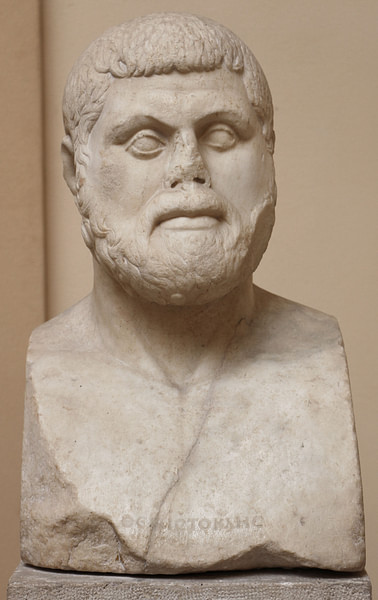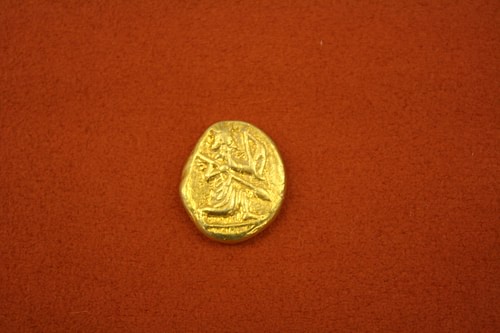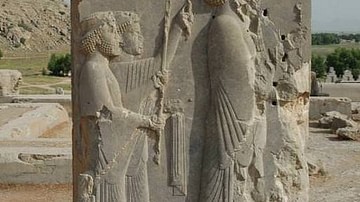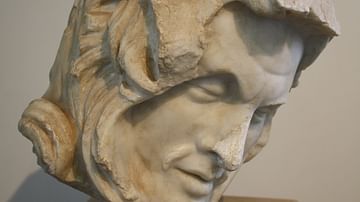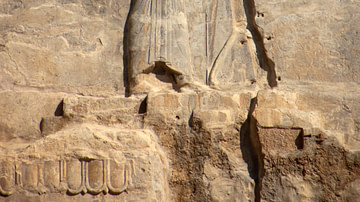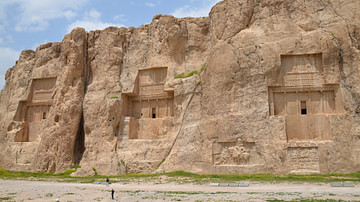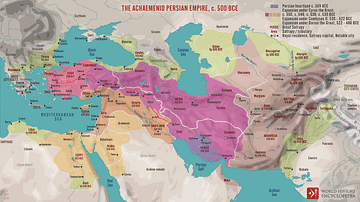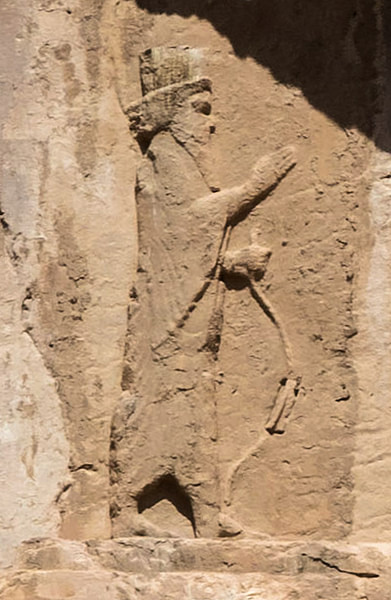
Artaxerxes I (r. 465-424 BCE) was the sixth monarch of the Achaemenid Persian Empire. He was the son of Xerxes I (r. 486-465 BCE) and his principal wife Amestris (d. 424 BCE) and grandson of Darius I (the Great, r. 522-486 BCE). He continued the Persian Wars with Greece initiated by both his predecessors, but preferred stealth and bribery to open war, finally bringing the struggle to a close with the Peace of Callias c. 449 BCE.
He had earlier welcomed the Athenian statesman and general Themistocles (l. c. 524 - c. 460 BCE) to his court after the Athenians had ostracized him in return for the offer to help the Persians crush the Greeks but Themistocles died before any military action was taken. Even without Themistocles' help, Artaxerxes I was still able to avenge his father's and grandfather's defeats by the Greeks through his exploitation of the tensions between Athens and Sparta by Sparta's military build-up, contributing to the Peloponnesian Wars (460-446 and 431-404 BCE) in Greece.
During his reign, Artaxerxes I completed the Hall of 100 Columns at Persepolis, rebuilt the palace of Darius I at Susa after a fire, and put down the revolt of Inaros II (c. 460-454 BCE) in Egypt. He also maintained the Persian policy of religious tolerance and autonomy and is probably best known through the biblical books of Ezra and Nehemiah where he is depicted as a great benefactor of the Jewish people, assisting them in the rebuilding of the temple at Jerusalem and the establishment of Mosaic Law.
Background & Rise to Power
The Achaemenid Empire was founded by Cyrus II (the Great, r. c. 550-530 BCE) who, among his many other notable achievements, allowed the Jews to return to Jerusalem, ending the Babylonian Captivity (c. 605-536 BCE). He was succeeded by his son, Cambyses II (r. 530-522 BCE) who conquered Egypt in 525 BCE and added it to the empire. Cambyses II died on his return trip and was briefly succeeded by a man who was either his brother Bardiya or an imposter named Gaumata who was killed and succeeded by Darius I.
In response to Athenian support of a revolt of Ionian Greeks in his empire, Darius I launched in invasion of mainland Greece in 490 BCE which was halted at the famous Battle of Marathon. Xerxes I then amassed a large army and attempted to finish what his father had started by a second invasion in 480 BCE, which was defeated by 479 BCE. Xerxes I returned home and occupied himself with building projects, women, and court intrigue until he was assassinated by his trusted official Artabanus in 465 BCE who may have also killed his son Darius.
Artaxerxes I had Artabanus and his sons executed for the murder and took the throne. Shortly before Xerxes I's death, he had been planning another action against Greece which was defeated before it could even begin at the Battle of the Eurymedon c. 466 BCE in an action commanded by the zealously anti-Persian Athenian general Cimon (l. c. 510 - c. 450 BCE). Artaxerxes I, in considering the string of defeats Greece had inflicted on Persia, recognized it would be more prudent to try some other means of destroying them besides open conflict. The answer to his question of how to do this seemed to present itself in the unlikely arrival at court of his father's enemy, the Greek general Themistocles.
Themistocles & Conflict with Greece
Themistocles was the mastermind who had orchestrated Xerxes I's defeat at the naval battle of Salamis in 480 BCE and was initially hailed as a great hero by the Athenians. By c. 471 BCE, however, he had fallen out of favor and was first officially exiled via ostracism and then falsely accused of treason and ordered to stand trial. Themistocles first fled to Argos, then Molossia, and finally wound up in the Ionian Greek colonies of Asia Minor where he made his way to the court of Artaxerxes I and presented himself to the king.
He told Artaxerxes I that, even though he had been his father's enemy in the war, he was now prepared, given his circumstances, to help the new king avenge the defeat and take Greece. Themistocles asked only for a year's time in which to learn the Persian language and customs and would then serve Artaxerxes I faithfully. The king granted him governorship of three cities (possibly more) and allowed his wife and children to be smuggled out of Athens and brought to him.
The precise date of Themistocles' arrival at court is unknown but it must have been shortly after Artaxerxes I came to power because that same year (465 BCE) he held the position of Governor of Magnesia as attested by coins he had minted. Artaxerxes I's activities at this time are also unclear (though, most likely, he was engaged in completing the work left unfinished by his father at Persepolis) but, whatever else he was doing, he was secretly encouraging tensions between Athens and Sparta by supplying the Spartans with enormous amounts of gold darics (coinage first minted under Darius I) featuring the image of a Persian archer. Scholar Kaveh Farrokh writes:
Ironically, these “coin archers” had far more influence than the imperial archers of the past Darius-Xerxes wars. Persian gold was now the Empire's major strength in the Aegean theater [of war]. (88)
After Xerxes I's defeat, the Athenians had created the Delian League in 478 BCE, an alliance of Greek city-states who agreed to set aside their differences to defend against the possibility of another Persian invasion and to liberate fellow Greeks from Persian rule. These city-states agreed to be led by Athens and the league's name came from the location of their treasury on the island of Delos. The Delian League was responsible for the victory over the Persians at the Eurymedon River c. 466 BCE and for eliminating piracy, which benefited everyone, but the main beneficiary was Athens who grew increasingly wealthy and powerful under the direction of Pericles (l. 495-429 BCE) who freely used the Delian League to empower his native city.
A number of city-states – in the league or not – objected to what appeared to be the creation of an Athenian Empire but none more so than Sparta. Artaxerxes I exploited this situation by funding Sparta's military build-up while making overtures of peace and gifts of gold darics to Athens. All he really needed to do now was wait until one of his enemies felt powerful enough to challenge the other.
In 460 BCE, Sparta asked Athens for assistance in putting down a rebellion of Helots but then insulted the Athenians when they arrived for reasons that are unclear. At this same time, however, the Spartans had finally grown tired of Athenian arrogance and, especially, the long defensive walls the Athenians had built around their city which, to many, seemed like preparation for war. The tensions finally erupted in 460 BCE with the First Peloponnesian War fought primarily between Athens and Corinth, an ally of Sparta.
With the outbreak of the hostilities he had been waiting for, Artaxerxes I now allegedly called upon Themistocles to fulfill his pledge and help him destroy Athens. According to Plutarch (l. c. 45 - c. 125 CE), Themistocles reconsidered his promise to the king, reflecting on how helping the Persians against his countrymen would destroy his reputation in history, and took his own life by drinking bull's blood or poison. The historian Thucydides (l. c. 460 - c. 400 BCE), however, claims Themistocles simply died of natural causes before Artaxerxes I could ask for his assistance.
The Egyptian & Megabyzus Revolt
Artaxerxes I was most likely considering another course of action when he was distracted by troubles in his Egyptian province. The Libyan prince Inaros II – who had ties to the Egyptian Saite Dynasty and allied himself with Amyrtaeus of Sais – rose in revolt against the occupying Persians in Egypt. He was supported by Athens and the rebellion was so unexpected and well-orchestrated that it took the Persians by surprise.
The Athenians had been planning to strike at Persian Cyprus in 460 BCE when Inaros II revolted and asked them for aid. Taking Egypt from Persia would be far more beneficial than the Cyprus possession and so Athens divided its forces between the war with Corinth and the rebels of Egypt.
The conflict continued for six years, during which the general Megabyzus (d. c. 440 BCE, who had served under Xerxes I in the 480 BCE invasion of Greece) commanded the Persian land forces in concert with the Persian satrap of Egypt, Arshama, leading the Persian fleet. The war did not go smoothly for the Persians at first since Inaros II proved to be a capable commander and, further, the rebel forces were being equipped and supported by Athens. Finally, in 454 BCE, Megabyzus defeated Inaros II and Arshama was victorious against the Athenian fleet just off the Delta region, restoring peace to Egypt under Persian rule.
Inaros II and 50 Greek generals were brought in chains to Susa where, according to the historian Ctesias (5th century BCE), the queen-mother Amestris called for their instant execution. Megabyzus, however, had given them his word of honor that they would not be harmed. Artaxerxes I respected Megabyzus' promise but Amestris did not and continued to hound her son until he relented. Inaros II was impaled and the generals beheaded.
This action so outraged Megabyzus that he returned to his satrapy, raised an army, and revolted. Megabyzus met the generals sent against him in single combat, refusing to allow Persians to war on each other, and spared their lives after defeating them. Artaxerxes I sent an embassy, which included Amestris, offering him an apology and the chance for peace and reconciliation. Megabyzus, feeling his honor had been restored, accepted and returned to the service of the king.
Further Greek Conflict & Peace
Around 450 BCE, while still fighting the First Peloponnesian War with Corinth, Athens renewed its earlier campaign to take Cyprus from Persia. The idea seemed to be to relaunch the revolt in Egypt by taking Cyprus as a staging area. A large fleet was launched, commanded by Cimon, which arrived at Cyprus and demanded its surrender. The island was well-fortified, however, and garrisoned with the troops of Megabyzus.
Cimon attacked, even though the defenses were formidable, and was killed at Citium. The attack was abandoned and the fleet withdrew. The Athenians did not seem to recognize that they would have done better to concentrate their full attention on the war with Sparta's Peloponnesian League (their answer to Athens' Delian League) than dividing their forces with continuous attacks on Persian territory.

Artaxerxes I, however, understood that something had to be done to keep Athens from interfering in his business and so sent an embassy to Athens, which included Megabyzus, offering peace. The Athenians responded by sending their master diplomat, the statesman Callias, to Susa where the Peace of Callias was negotiated. Farrokh describes the terms:
The treaty officially put an end to the wars of conquest initiated by Darius the Great. Both sides recognized their respective spheres of interest and pledged not to interfere in each other's affairs. The Achaemenids would refrain from interfering in the Aegean, while the Greeks would recognize Persian authority over Anatolia, especially along the Ionian coast. Persia also pledged to provide autonomy for its Ionian subjects…While Callias attempted [a lasting peace], the treaty, like many others, failed to alleviate the state of distrust between the two powers. (87)
Even so, the treaty would keep hostilities from erupting between Athens and Persia for the remainder of Artaxerxes I's reign.
Family, Buildings, & Biblical Narratives
While dealing with the Greeks, Egyptians, and other affairs of state, Artaxerxes I also, of course, had a domestic life. He was married to the queen Damaspia with whom he had one son, his heir Xerxes II (r. 424 BCE), but had many other children through his concubines including Sogdianus (r. 424 BCE) who briefly succeeded Xerxes II and the future queen Parysatis (5th century BCE) who would come to wield enormous power during and after the reign of Darius II (424-404 BCE). Artaxerxes I is described by the Greek historians as a gentle and studious man, given to reflection, but no mention is made of his home life other than the names of his various children.
He favored the city of Susa and made a number of improvements to it. When the palace of Darius I was destroyed in a huge fire that swept the city, Artaxerxes I had it rebuilt, though on a smaller scale, along with many other buildings and temples. At Persepolis, he completed the impressive Hall of 100 Columns begun by his father and also oversaw, long-distance, the rebuilding of the Temple of Solomon in Jerusalem.
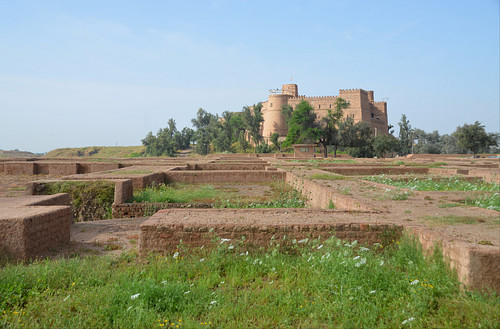
He is the central character of the biblical Book of Ezra and also appears in the Book of Nehemiah. Ezra was a priest and scribe at Susa who was sent by Artaxerxes I, along with a significant number of Jewish families, to Jerusalem in order to standardize the Law of Moses. He is said to have consolidated and edited the Mosaic Law which would then regulate the lives of the Jews in the region, suggesting the high level of autonomy Artaxerxes I granted to them.
Nehemiah was a high official at Artaxerxes I's court, said to be his cupbearer – and so confidante – who was distressed that Jerusalem's walls were in ruin and the city was left with no defenses. Artaxerxes I appointed him Governor of Judea and sent him to personally oversee the rebuilding of the walls. Although scholars differ on the interpretation and chronology of these two biblical narratives, it seems that Ezra and Nehemiah were contemporaries who worked together to reconcile the Jewish people to Persian rule while also allowing them freedom to develop their own culture and religion.
Conclusion
Artaxerxes I died of natural causes in 424 BCE, having ensured a peaceful succession by naming Xerxes II his legitimate heir. Xerxes II reigned for only a little over a month, however, before he was assassinated by Sogdianus. Sogdianus had the support of a segment of the nobles and ruled for six months before he was assassinated by his half-brother Nochus (also given as Ochus) who took the throne name Darius II.
Artaxerxes I's hopes of peaceful succession, therefore, were not realized, and Darius II, further, had to put down rebellions in various satrapies following his coup. Under Darius II's reign, the grandson of Amyrtaeus of Sais (who had led the revolt with Inaros II), also known as Amyrtaeus, founded the 28th Dynasty of Egypt and drove the Persians out of the Delta region of Lower Egypt, leaving them only Upper Egypt as a source of grain and other goods.
The Peace of Callias only lasted until 412 BCE when Darius II broke the treaty by giving aid to Sparta during the Second Peloponnesian War (431-404 BCE) and enabled them to defeat Athens. Darius II, in fact, undid many of the more notable accomplishments of his father's reign, but Artaxerxes I is still remembered as an effective monarch who did the best for his people and upheld the values of the empire.
